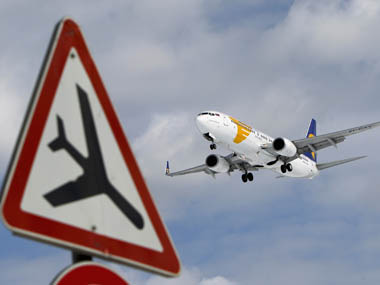By Kyle Peterson and Tim Hepher Chicago/Paris: There are, so the industry saying goes, only three secrets in the commercial airplane business: the selling price, the production cost and the shape of the wing. Boeing and Airbus are testing that proverb to the limits as they squeeze improvements out of the wings of their most popular jets to make them more aerodynamic — hunting down extra pennies per gallon of fuel savings for ultra-thrifty airlines. Boeing on Wednesday trumpeted its latest achievement in aerodynamics as it battles Airbus — wingtip to wingtip — for the lion’s share of a $2 trillion market for narrow-body Boeing 737 and Airbus A320 models over the next two decades. [caption id=“attachment_297640” align=“alignleft” width=“380” caption=“Reuters”]  [/caption] The US planemaker says its eye-catching new open-jawed wingtip design will allow its future Boeing 737 MAX to use 1.5 percent less fuel. That’s on top of already-targeted savings of 10-12 percent compared to the current 737. The design, with the wing split at the end and angled both upwards and downwards, will become a familiar sight in airports from 2017 when the $95 million 737 MAX is due to enter service. The device, known as a winglet, is the latest example of contortions in wing design to improve efficiency and updates the upward-slanting wingtip already familiar to many 737 passengers. Airbus last week assembled the first A320 fitted with its own version of the bent-back wingtip design, dubbed Sharklets, which will enter service in the final quarter of this year. “A lot of work has been done and it’s quite clear that no one approach has emerged that would be considered the best standard approach,” said Hans Weber, president of technology management consultancy Tecop International. Boeing and Airbus are using the wing enhancements as key selling points for their latest revamped models, with tens of billions of dollars of sales for both firms at stake each year. Their research is as jealously guarded as the price discounts they offer to airlines and the cost of churning out their cash-cow narrowbody jets at the rate of over one a day. Until now Airbus has used a smaller boomerang-shaped device called a wingtip fence on the A320 to combat the whirling currents or vortices that build up at the wingtip, causing drag. Boeing says its new forked design would save some $160,000 a year for a typical airline flying on the longer 737 MAX routes. Airbus played down the change. “This kind of split tip device was amongst the options we studied for the A320 family and we decided to advance with our Sharklet design,” a spokeswoman for the European EADS subsidiary said. Inside the box Boeing unveiled the spiky wingtip design on the 60th anniversary of the birth of commercial passenger jet service with the introduction of the De Havilland Comet on 2 May 1952. Six decades on, planemakers are still looking for the elusive perfect wing for commercial transport because the most economic solution is in reality a compromise for each model. A long slender wing tends to provide more lift but is heavier. A short stubby wing is lighter but less efficient. Throughout much of the jet era it was considered uneconomical to take the fight against drag to the extreme edge of the wing for what would at best be an incremental improvement. But the 1973 oil shock prompted NASA-led research that led to the first winglets and recent record oil prices have made the 500-mph aerial racetrack at the wingtip a big business. Airbus is locked in a legal dispute with Boeing’s partner in its previous generation of winglets, Aviation Partners Inc, which claims Airbus infringed its patent and demands royalties. Airbus rejects the claims and describes them as a hindrance. The industry is investing in such tweaks because the forces that make the rest of the wing work cause problems at the tip. “The air that goes over the wing has to accelerate because it’s bent out of the way,” Weber said. “The air under the wing basically goes flat and doesn’t change very much.” It is the difference between speeds, and therefore pressure, over and under the wing that causes lift. Near the tip, the two air currents clash, creating drag that erodes fuel efficiency. Continues on the next page Curved winglets blunt the transition between air flows. Experts note that while winglets cut drag, they also add weight which eats into the fuel savings. “Nothing in life is for free,” Weber said. “It does reduce the drag, but at a cost.” That’s not all. Designers face a further serious headache. The 737 and A320 must fit into the box provided for aircraft of their category at airport parking stands. Gates for the larger categories are scarcer and more expensive. For most operators losing the current status would add significant costs. Their aircraft pour in and out of airports feeding hubs or serving low-cost markets several times a day. [caption id=“attachment_297640” align=“alignleft” width=“380” caption=“Reuters”]  [/caption] With existing winglets, the 737 wingspan is close to the 36-meter limit for airplanes of its class. Breaking out of the so-called ‘C’ category could be a commercial disaster, both for the airline and its jetmaker, which would quickly lose its business. Wing experts therefore have been called on by both leading manufacturers to put their aircraft on a yoga course and come up with ways of increasing the wingspan through various contortions in the shape of the wingtip without breaching the size limits. Boeing says its design keeps the all-important ‘C’ category. Larger jets face the same problem, with Boeing pondering how to give its 777 wide-body a performance boost without pushing it into a costly superjumbo category by over-extending the wing. In the past, engineers have even considered putting folding wings on the stately 777 like a 1960s carrier-based attack plane, but abandoned the idea because the hydraulics needed to fold and lock them would pile on maintenance risk and weight. Reuters
Boeing and Airbus are trying to improve the wings of their most popular jets to make them more aerodynamic, and more fuel-efficient.
Advertisement
End of Article
Written by FP Archives
see more


)

)
)
)
)
)
)
)
)



